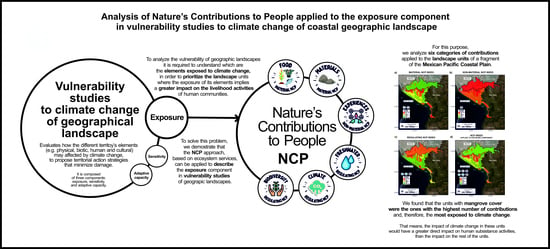Nature’s Contributions to People in Vulnerability Studies When Assessing the Impact of Climate Change on Coastal Landscapes
Abstract
:1. Introduction
Context of the Case Study
2. Materials and Methods
- (1)
- Delimitation of landscape units, carried out through an ecological regionalization.
- (2)
- NCP analysis process: selection of contributions per board group, design of indicators to evaluate the contributions, and calculation of each contribution board group index in the landscape units.
- (3)
- Analysis of total NCP index as a description of the exposure component, assuming that the units with the highest contributions are units with the highest exposure value, in a range from 0 to 100.
2.1. Delimitation of Landscape Units
2.2. NCP Analysis Process
2.3. Analysis of Total NCP Index as a Description of the Exposure Component
3. Results and Discussion
3.1. Description of the Ecological Landscape Units
3.2. Analysis of NCP Index Board Groups
3.2.1. Material Contributions
Food
Materials
3.2.2. Non-Material Contributions
Experiences
3.2.3. Regulating Contributions
Freshwater
Climate
Biodiversity
3.3. Analysis of the NCP Index Describing the Exposure Component
4. Considerations, Limitations and Final Conclusions
- (1)
- It describes the elements of the landscape units based on anthropic contributions/uses, based on the theory of ecosystem services analysis and respecting the complexity of the geographic landscape. The surface magnitude of the landscape units being the spatial limit but not the absolute value of the exposure indicator, as criticised in other research [11].
- (2)
- It prioritizes the exposure of the units in terms of these uses, and consequently, of the direct impact of climate change on human activities. Following the comments of Rodríguez [8], since vulnerability and geographic units are the product of a social construction, identifying the landscape units with the highest NCP is conducive to seeking actions for their conservation in order to maintain the survival of humans.
- (3)
- It focuses the vulnerability study on proposing adaptation measures based on the idea of conservation rather than compensation, for example, nature-based adaptation strategies aimed at conserving land covers that maintain ecosystems and contributions. These solutions are translated into public policies to reduce vulnerability to climate change and are aligned with the strategies in the international discourse of the UNEP. Research suggests that the EbA approach should be implemented for the sustainable conservation of Mexican coasts [20].
Supplementary Materials
Author Contributions
Funding
Data Availability Statement
Acknowledgments
Conflicts of Interest
References
- Intergovernmental Panel on Climate Change (IPCC). AR5 Climate Change 2014: Impacts, Adaptation, and Vulnerability. Available online: https://www.ipcc.ch/report/ar5/wg2 (accessed on 16 January 2022).
- Füssel, H.M. Vulnerability: A generally applicable conceptual framework for climate change research. Glob. Environ. Chang. 2007, 17, 155–167. [Google Scholar] [CrossRef]
- Füssel, H.M.; Klein, R.J.T. Climate change vulnerability assessments an evolution of conceptual thinking. Clim. Chang. 2006, 75, 301–329. [Google Scholar] [CrossRef]
- Gallopín, G.C. Linkages between vulnerability, resilience, and adaptive capacity. Glob. Environ. Chang. 2006, 16, 293–303. [Google Scholar] [CrossRef]
- Tonmoy, F.N.; El-Zein, A.; Hinkel, J. Assessment of vulnerability to climate change using indicators: A meta-analysis of the literature. WIREs Clim. Chang. 2014, 5, 775–792. [Google Scholar] [CrossRef] [Green Version]
- Nájera, A.; Carrillo, F.M. Vulnerability assessment studies on climate change: A review from the research in México. Atmósfera 2022, 35, 179–196. [Google Scholar] [CrossRef]
- Coy, M. Los estudios de riesgo y de la vulnerabilidad desde la geografía humana. Su relevancia para América Latina. Población Soc. 2010, 17, 9–28. Available online: https://www.redalyc.org/pdf/3869/386939743002.pdf (accessed on 16 January 2022).
- Rodríguez, J.M. El paisaje geográfico en la gestión de desastres. Aportaciones y limitaciones. Rev. Col. San Luis 2020, 10, 1–28. [Google Scholar] [CrossRef]
- Bocco, G.; Mendoza, M.; Priego, Á.; Burgos, A. La Cartografía de los Sistemas Naturales Como Base Geográfica Para la Planeación Territorial. Una Revisión Bibliográfica; INE-SEMARNAT: Mexico City, Mexico, 2009; ISBN 978-968-817-920-8. [Google Scholar]
- Bertrand, G.; Bertrand, C. Geografía del Medio Ambiente. El Sistema GTP: Geosistema, Territorio y Paisaje; UGR: Grenada, Spain, 2006; ISBN 978-843-384-537-5. [Google Scholar]
- Cárdenas, M.F.; Tobón, C. Evaluación de la vulnerabilidad biofísica de los servicios ecosistémicos ante el cambio climático: Una aproximación conceptual y metodológica. Gestión Ambiente 2016, 19, 163–178. Available online: https://revistas.unal.edu.co/index.php/gestion/article/view/54383 (accessed on 16 January 2022).
- Díaz, S.; Pascual, U.; Stenseke, M.; Martín-López, B.; Watson, R.T.; Molnár, Z.; Hill, R.; Chan, K.M.A.; Baste, I.A.; Brauman, K.A.; et al. Assessing nature’s contributions to people. Science 2018, 359, 270–272. [Google Scholar] [CrossRef] [Green Version]
- Brauman, K.A.; Garibaldi, L.A.; Polasky, S.; Aumeeruddy-Thomas, Y.; Brancalion, P.H.S.; DeClerck, F.; Jacob, U.; Mastrangelo, E.; Nkongolo, N.V.; Palang, H.; et al. Global trends in nature’s contributions to people. Proc. Natl. Acad. Sci. USA 2020, 117, 32799–32805. [Google Scholar] [CrossRef]
- Instituto Nacional de Estadística y Geografía (INEGI). Serie cartográfica de Fisiografía. Escala 1:1 000 000. Available online: https://www.inegi.org.mx/temas/fisiografia/ (accessed on 16 January 2022).
- Bojórquez, I.; Nájera, O.; Hernández, A.; Flores, F.; González, A.; García, D.J.; Madueño, A. Particularidades de formación y principales suelos de la llanura costera norte del estado de Nayarit, México. Cultiv. Trop. 2006, 27, 19–24. Available online: https://www.redalyc.org/pdf/1932/193215912003.pdf (accessed on 16 January 2022).
- González, A.; Bojórquez, I.; Nájera, O.; García, J.D.; Madueño, A.; Flores, F. Regionalización ecológica de la llanura costera norte de Nayarit. Investig. Geográficas 2009, 69, 21–32. [Google Scholar] [CrossRef]
- De la Lanza, G.; Gómez, J.C.; Blanco, M.; Flores-Verdugo, F.; Hernández, S. Vulnerabilidad costera: Caso de estudio del sistema de humedales de Marismas Nacionales. In Cambio Climático en México: Un Enfoque Costero y Marino; Rivera, E., Azuz, I., Alpuche, L., Villalobos, G., Eds.; UACAM: Campeche, Mexico, 2010; pp. 205–230. ISBN 978-607-7887-19-5. [Google Scholar]
- Instituto Nacional de Estadística y Geografía (INEGI). Censo de Población y Vivienda 2010. Available online: https://www.inegi.org.mx/programas/ccpv/2010/ (accessed on 16 January 2022).
- Nájera, A.; Carrillo, F.M.; Morales, J.C.; Nájera, O. Cambio de cobertura y uso de suelo en llanura costera asociados a procesos antropogénicos: Caso San Blas, Nayarit. Madera Bosques 2021, 27, e2712104. [Google Scholar] [CrossRef]
- Carranza-Ortiz, G.; Gómez-Mendoza, L.; Caetano, E.; Infante, D. Vulnerability of human communities in Mexican mangrove ecosystems: An ecosystem-based adaptation approach. Investig. Geográficas 2018, 95, 1–18. [Google Scholar] [CrossRef]
- United States Geological Survey (USGS). Earth Explorer. Available online: https://earthexplorer.usgs.gov/ (accessed on 16 January 2022).
- García, A.; Muñoz, J. El Paisaje en el Ámbito de la Geografía; UNAM: Mexico City, Mexico, 2002; ISBN 968-36-9856-5. [Google Scholar]
- Herrera, J.A.; Bojórquez, I.; Hernández, A.; Can-Chulim, A. Paisajes geomorfoedafológicos y regularidades de distribución de suelos en San Blas, Nayarit, México. Rev. Bio Cienc. 2020, 7, 1–19. [Google Scholar] [CrossRef]
- Berlanga-Robles, C.; Ruiz-Luna, A. Evaluación de cambios en el paisaje y sus efectos sobre los humedales costeros del sistema estuarino de San Blas, Nayarit (México) por medio de análisis de imágenes Landsat. Cienc. Mar. 2006, 32, 523–538. [Google Scholar] [CrossRef] [Green Version]
- Chaplin-Kramer, R.; Sharp, R.P.; Weil, C.; Bennett, E.M.; Pascual, U.; Arkema, K.K.; Brauman, K.A.; Bryant, B.P.; Guerry, A.D.; Haddad, N.M.; et al. Global modeling of nature’s contributions to people. Science 2019, 366, 255–258. [Google Scholar] [CrossRef]
- Bondé, L.; Assis, J.C.; Benavides-Gordillo, S.; Canales-Gómez, E.; Fajardo, J.; Marrón-Becerra, A.; Noruega-Urbano, E.A.; Weidlich, E.W.A.; Ament, J.M. Scenario-modelling for the sustainable management of non-timber forest products in tropical ecosystems. Biota Neotrop. 2020, 20, e20190898. [Google Scholar] [CrossRef]
- Schuschny, A.; Soto, H. Guía Metodológica Diseño de Indicadores Compuestos Para el Desarrollo Sostenible; CEPAL: Santiago de Chile, Chile, 2009; Available online: https://www.bivica.org/file/view/id/2485 (accessed on 16 January 2022).
- Secretaria de Agricultura y Desarrollo Rural (SADER). Servicio Nacional de Información Agroalimentaria y Pesquera (SIAP). Available online: https://www.gob.mx/siap (accessed on 16 January 2022).
- Núñez, V.H. Determinación del uso de la Madera de Manglar: Impactos Socioambientales en el Ejido San Blas, Nayarit, México. Master’s Thesis, Universidad Autónoma de Nayarit, Tepic, Mexico, 2016. [Google Scholar]
- Comisión Nacional de Agua (CONAGUA). Registro Público de Derechos del Agua (REPDA). Available online: https://app.conagua.gob.mx/ConsultaRepda.aspx (accessed on 16 January 2022).
- Instituto Mexicano del Transporte (IMT). Red Nacional de Caminos. Available online: https://www.gob.mx/imt/acciones-y-programas/red-nacional-de-caminos (accessed on 16 January 2022).
- Valdés, E.; Valdez-Hernández, J.I.; Ordaz, V.M.; Gallardo, J.F.; Pérez, J.; Ayala, C. Evaluación del carbono orgánico en suelos de los manglares de Nayarit. Rev. Mex. Cienc. For. 2011, 2, 47–58. [Google Scholar] [CrossRef] [Green Version]
- Murray-Núñez, R.M.; Bojórquez, I.; Hernández, A.; García, J.D.; Madueño, A.; Bugarin, R.; Orozco, M.G. Perdida de carbono en suelos de la llanura costera de Nayarit, México. Rev. Bio Cienc. 2012, 1, 38–46. [Google Scholar] [CrossRef]
- Murray-Núñez, R.M.; Nájera, O.; Orozco, M.G.; Bojórquez, I. Cambios en carbono orgánico en suelos cambisoles, solonetz y arenosoles. Rev. Iberoam. Las Cienc. Biológicas Agropecu. 2015, 4, 22–40. Available online: https://www.ciba.org.mx/index.php/CIBA/article/view/31/94 (accessed on 16 January 2022).
- Rivera, M.Y. Reservas de Carbón en Biomasa Aérea del Bosque de Manglar. Master’s Thesis, Universidad Autónoma de Nayarit, Tepic, Mexico, 2015. [Google Scholar]
- Agraz-Hernández, C.M.; Chan-Keb, C.A.; Chávez-Barrera, J.; Osti-Sáenz, J.; Expósito-Díaz, G.; Alonso-Campos, V.A.; Muñiz-Salazar, R.; Ruiz-Fernández, A.C.; Pérez-Bernal, L.H.; Sánchez-Cabeza, J.A.; et al. Reserva de carbón en un ecosistema de manglar al norte de México: Cambios ambientales durante 35 años. Rev. Mex. Biodivers. 2020, 91, 1–19. [Google Scholar] [CrossRef]
- Comisión Nacional Para el Conocimiento y Uso de la Biodiversidad (CONABIO). Índice de Integridad Ecológica (IIE) Escala: 1:250000. Available online: http://magrat.mine.nu:8088/geonetwork/srv/api/records/a5d63dbc-4d3f-4aee-8728-adf9f507b6a9 (accessed on 16 January 2022).
- Mora, F. A Spatial Framework for Detecting Anthropogenic Impacts on Predator-Prey Interactions that Sustain Ecological Integrity in México. Ecol. Processes 2018, 7, 35. [Google Scholar] [CrossRef]
- Ruiz-Frau, A.; Ospina-Álvarez, A.; Villasante, S.; Pita, P.; Maya-Jariego, I.; De Juan, S. Using graph theory and social media data to assess cultural ecoystem services in coastal area: Method development and application. Ecosyst. Serv. 2020, 45, 101176. [Google Scholar] [CrossRef]
- Cohen, J. A coefficient of agreement of nominal scales. Educ. Pshychol. Meas. 1960, 20, 37–46. [Google Scholar] [CrossRef]
- Landis, J.R.; Koch, G.G. The measurement of observer agreement for categorical data. Biometrics 1977, 33, 159–174. [Google Scholar] [CrossRef] [Green Version]
- López, W.; Reynoso, R.; Castro, I.; Salinas, E.; Magdaleno, R. Capacidad de infiltración de la cuenca del río Cuxtepeques, Chiapas, México. Ing. Hidráulica Ambient. 2016, 37, 103–112. Available online: http://scielo.sld.cu/pdf/riha/v37n3/riha08316.pdf (accessed on 16 January 2022).
- Nájera, A.; Carrillo, F.M.; Nájera, O.; Chavéz-Dagostino, R.M. Caracterización climática y variabilidad de temperatura superficial de la llanura costera de Nayarit y su teleconexión con ENSO y PDO. Acta Univ. 2020, 30, 1–21. [Google Scholar] [CrossRef]
- Diario Oficial de la Federación. Norma Oficial Mexicana NOM-011-CNA-2000, Conservación del Recurso Agua- Que Estable las Especificaciones y el Método Para Determinar la Disponibilidad Media Anual de las Aguas Nacionales. Available online: https://www.dof.gob.mx/nota_detalle.php?codigo=734510&fecha=17/04/2002 (accessed on 16 January 2022).
- Lara-Domínguez, A.L.; Yáñez-Arancibia, A.; Seijo, J.C. Valuación económica de los servicios de los ecosistemas: Estudio de caso de los manglares en Campeche. In Aspectos Económicos Sobre la Biodiversidad de México; Benítez, H., Vega, E., Peña, A., Ávila, S., Eds.; CONABIO-SEMARNAP: Mexico City, Mexico, 1998; pp. 23–44. ISBN 970-9000-05-5. [Google Scholar]
- Comisión Nacional del Agua (CONAGUA). Manual de Agua Potable, Alcantarillado y Saneamiento. Datos Básicos Para Proyectos de Agua Potable y Alcantarillado; SEMARNAT: Mexico City, Mexico, 2019; ISBN 978-607-626-036-4. [Google Scholar]
- Comisión Nacional Para el Conocimiento y Uso de la Biodiversidad (CONABIO). Cuencas Hidrográficas de México. Available online: http://www.conabio.gob.mx/informacion/gis/ (accessed on 16 January 2022).
- Sanjurjo, E.; Welsh, S. Una descripción del valor de los bienes y servicios ambientales prestados por los manglares. Gac. Ecológica 2005, 7, 55–68. Available online: https://dialnet.unirioja.es/servlet/articulo?codigo=2881023 (accessed on 19 January 2022).
- Valdez-Hernández, J.I. Manejo forestal de un manglar al sur de Marismas Nacionales, Nayarit. Madera Bosques 2004, 10, 93–104. [Google Scholar] [CrossRef]
- García, L.; Camelo, J.C. San Blas, Nayarit; México. La Historia Económica del Puerto Mercante y Agricultor que se Convirtió en Destino Turístico (1768–2010); Eumed: Malaga, Spain, 2016; Available online: https://www.eumed.net/libros-gratis/2016/1520/index.htm (accessed on 16 January 2022).
- Comisión Nacional de Áreas Naturales Protegidas (CONANP). Sitios Ramsar. Available online: https://ramsar.conanp.gob.mx/index.php/sitios-ramsar/ (accessed on 16 January 2022).
- Comisión Nacional del Agua (CONAGUA). Inventario de Plantas Municipales de Potabilización y de Tratamiento de Aguas Residuales en Operación. Available online: https://www.gob.mx/conagua/documentos/inventario-de-plantas-municipales-de-potabilizacion-y-de-tratamiento-de-aguas-residuales-en-operacion (accessed on 16 January 2022).
- Herrera, J.A.; Camacho, A.; Pech, E.; Pech, M.; Ramírez, J.; Teutli, C. Carbon dynamics (stocks and fluxes) in mangroves of Mexico. Terra Lat. 2016, 34, 61–72. Available online: http://www.scielo.org.mx/scielo.php?script=sci_arttext&pid=S0187-57792016000100061 (accessed on 16 January 2022).
- Sánchez-Quinto, A.; Correa, J.; Zamboni, N.S.; Sanches, F.H.C.; Principe, S.C.; Viotto, E.E.; Casagranda, E.; da Veiga-Lima, F.A.; Possamai, B.; Faroni-Perez, L. Development of a conceptual framework for the management of biodiversity and ecosystem services in the Mexican Caribbean. Biota Neotrop. 2020, 20, e20190901. [Google Scholar] [CrossRef]
- Pascual, U.; Balvanera, P.; Díaz, S.; Pataki, G.; Roth, E.; Stenseke, M.; Watson, R.T.; Dessane, E.B.; Islar, M.; Kelemen, E.; et al. Valuating nature’s contributions to people: The IPBES approach. Curr. Opin. Environ. Sustain. 2017, 26–27, 7–16. [Google Scholar] [CrossRef] [Green Version]
- Ho, Y.-S.; Mukul, S.A. Publication Performance and Trends in Mangrove Forests: A Bibliometric Analysis. Sustainability 2021, 13, 12532. [Google Scholar] [CrossRef]
- Aburto-Oropeza, O.; Ezcurra, E.; Danemann, G.; Valdez, V.; Murray, J.; Sala, E. Mangroves in the Gulf of California increase fishery yields. Proc. Natl. Acad. Sci. USA 2008, 105, 10456–10459. [Google Scholar] [CrossRef] [Green Version]
- Guzmán, S.; Rodríguez, G.; Mejía, C. Análisis de Presupuesto Internacional y Nacional Público para Cambio Climático; Detusche Gesellschaft für Internationale Zusammenarbeit (GIZ): Bonn, Germany, 2018; Available online: https://iki-alliance.mx/wp-content/uploads/An%C3%A1lisis-de-Presupuesto-Internacional-y-Nacional-P%C3%BAblico-para-Cambio-Clim%C3%A1tico_VF171218.pdf (accessed on 20 January 2022).
- Kumagai, J.A.; Costa, M.T.; Ezcurra, E.; Aburto-Oropeza, O. Prioritizing mangrove conservation across Mexico to facilitate 2020 NDC ambition. Ambio 2020, 49, 1992–2002. [Google Scholar] [CrossRef]
- López-Toache, V.; Romero-Amado, J.; Toache-Berttolini, G.; García-Sánchez, S. Bonos de carbono: Financiarización del medioambiente en México. Estud. Soc. 2016, 25, 189–215. Available online: https://www.ciad.mx/estudiosociales/index.php/es/article/view/314 (accessed on 7 March 2022).
- Zeng, Y.; Friess, D.A.; Sarira, T.V.; Siman, K.; Koh, L.P. Global potential and limits of mangrove blue carbon for climate change mitigation. Curr. Biol. 2021, 31, 1737–1743.e3. [Google Scholar] [CrossRef]
- United Nations Environment Programme (UNEP). Ecosystem-Based Adaptation. Available online: https://www.unep.org/explore-topics/climate-action/what-we-do/climate-adaptation/ecosystem-based-adaptation (accessed on 7 March 2022).
- International Institute for Sustainable Development (IISD). Seeking Common Ground for climate, Biodiversity, and People: How to get the Debate on Nature-Based Solutions Right. Available online: https://www.iisd.org/articles/common-ground-nature?fbclid=IwAR2bkE4Zsefg22nh6doalHLtJ5SObcdgs_o6Me2O6ZZ9N-zdf2DcAU-7Row (accessed on 7 March 2022).
- Braat, L.C.; de Groot, R. The ecosystem services agenda: Bridging the worlds of natural science and economics, conservation and development, and public and private policy. Ecosyst. Serv. 2012, 1, 4–15. [Google Scholar] [CrossRef] [Green Version]
- Patty De La Cruz [@patriciadlcruzvillafuentes]. En San Blas Disfrutando un Platillo Especial de Camarones Empanizados de coco! #sanblasnayarit #food #delisioso #delicious. Available online: https://www.instagram.com/p/BapcnRanEBd/ (accessed on 24 October 2017).
- El Pato Hernandez [@elpatohernandezbarrera]. #sanblasnayarit. Available online: https://www.instagram.com/p/BMdXujzj9Gy/ (accessed on 6 November 2016).
- Hugo Alejandro García Murillo [@hgarmur]. San Blas, Nayarit, México #sanblas #sanblasnayarit #nayarit #mexico #nayaritenamora #sea #beach #playa. Available online: https://www.instagram.com/p/Bwn0znZJx5p/ (accessed on 24 April 2019).
- Roberto Zepeda [@djrobertzphoto]. Baby croc #sanblasnayarit #nayarit #sedetur #saboresdenayarit @natgeo @natgeotravel #crocodile #cocodrilo. Available online: https://www.instagram.com/p/-vU54yQt2v/ (accessed on 1 December 2015).
- Festival de Aves Migratorias [@fiamsanblas]. Jóvenes Voluntarios en su día de capacitación. #SomosPafiam #SanBlasNayarit #FestivalInternacionalDeAvesMigratorias. Available online: https://www.instagram.com/p/BL_oQACAah7/ (accessed on 25 October 2016).
- Francisco Chapa Kiko [kiko_chapa]. Sesión #SanBlas #Sanblasnayarit #Libre #water #mar #sea #Libre #sunset #palmeras #palmas. Available online: https://www.instagram.com/p/2r5ZgOmUp2/ (accessed on 15 May 2015).
- Muro SB [@muro_sb]. #sanblasnayarit. Available online: https://www.instagram.com/p/4an-h-LRt5/ (accessed on 27 June 2015).
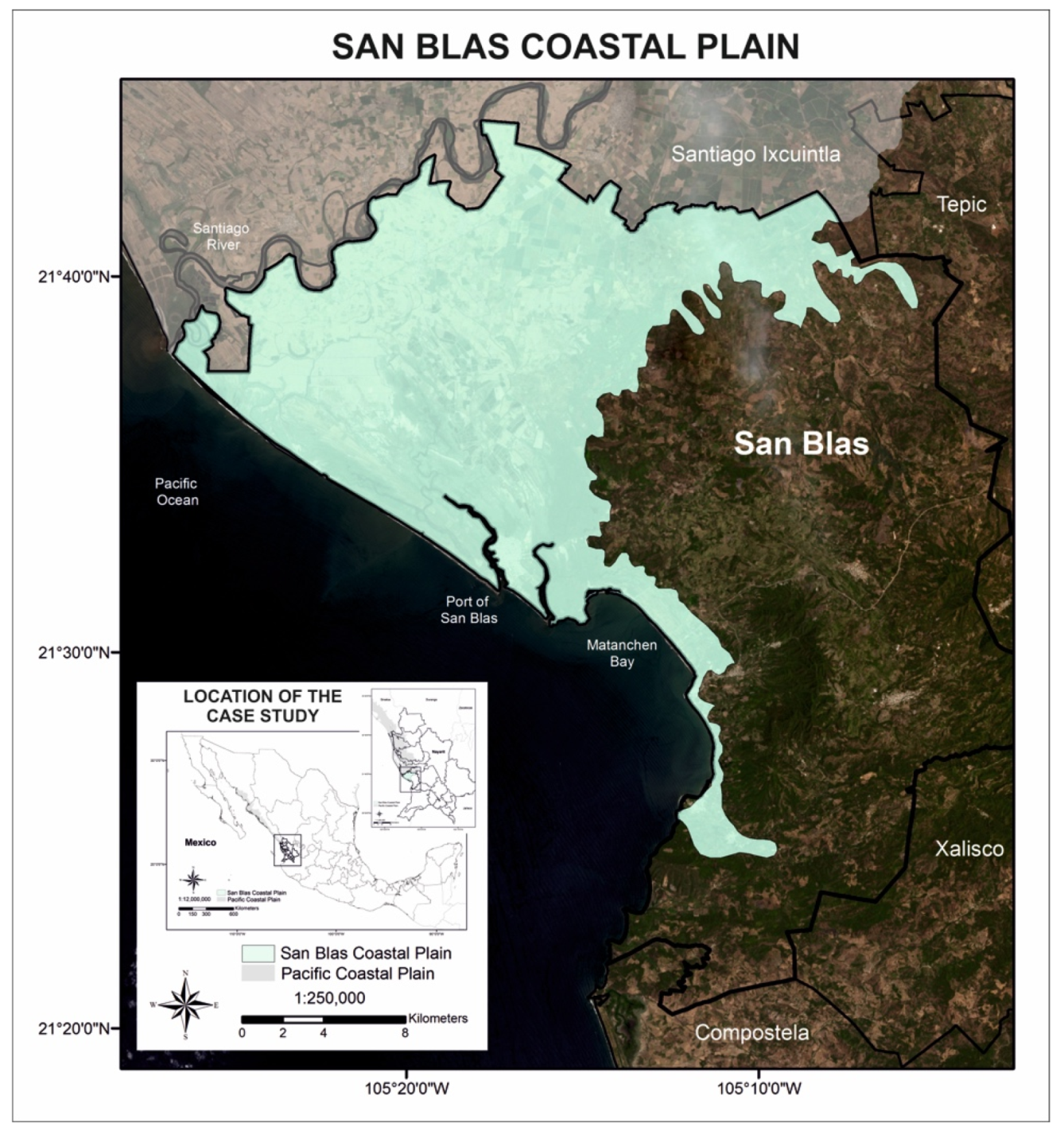
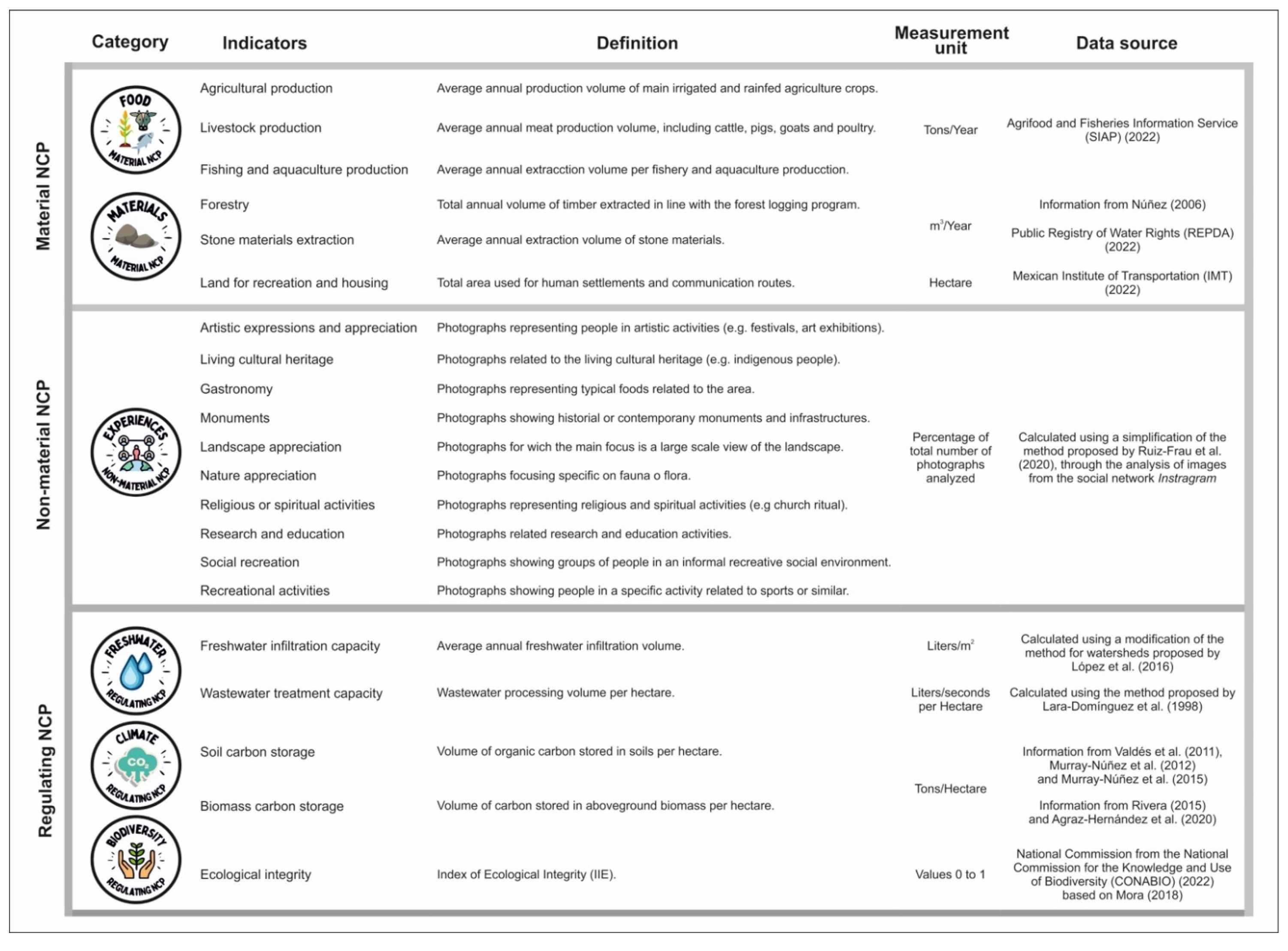
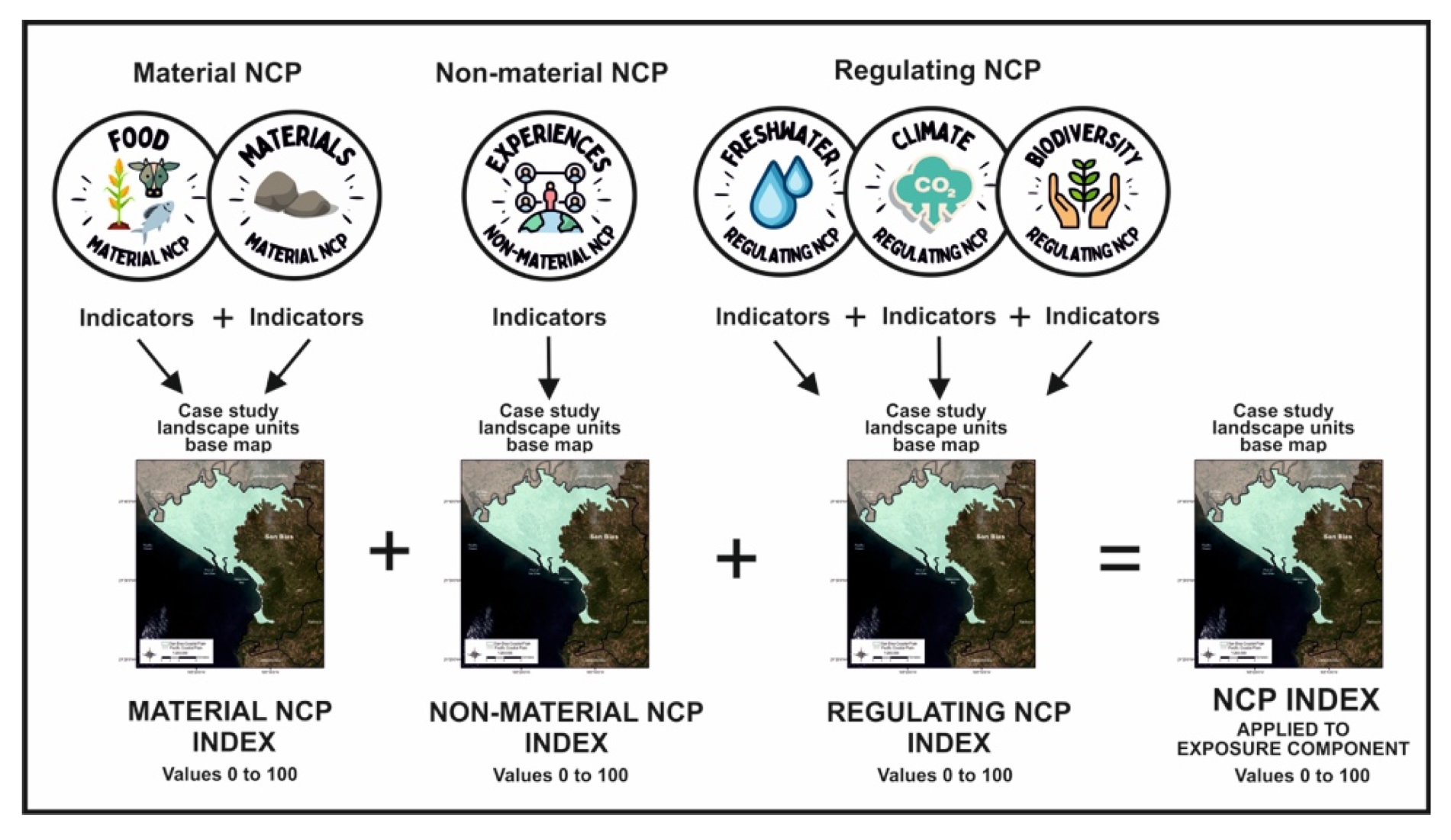
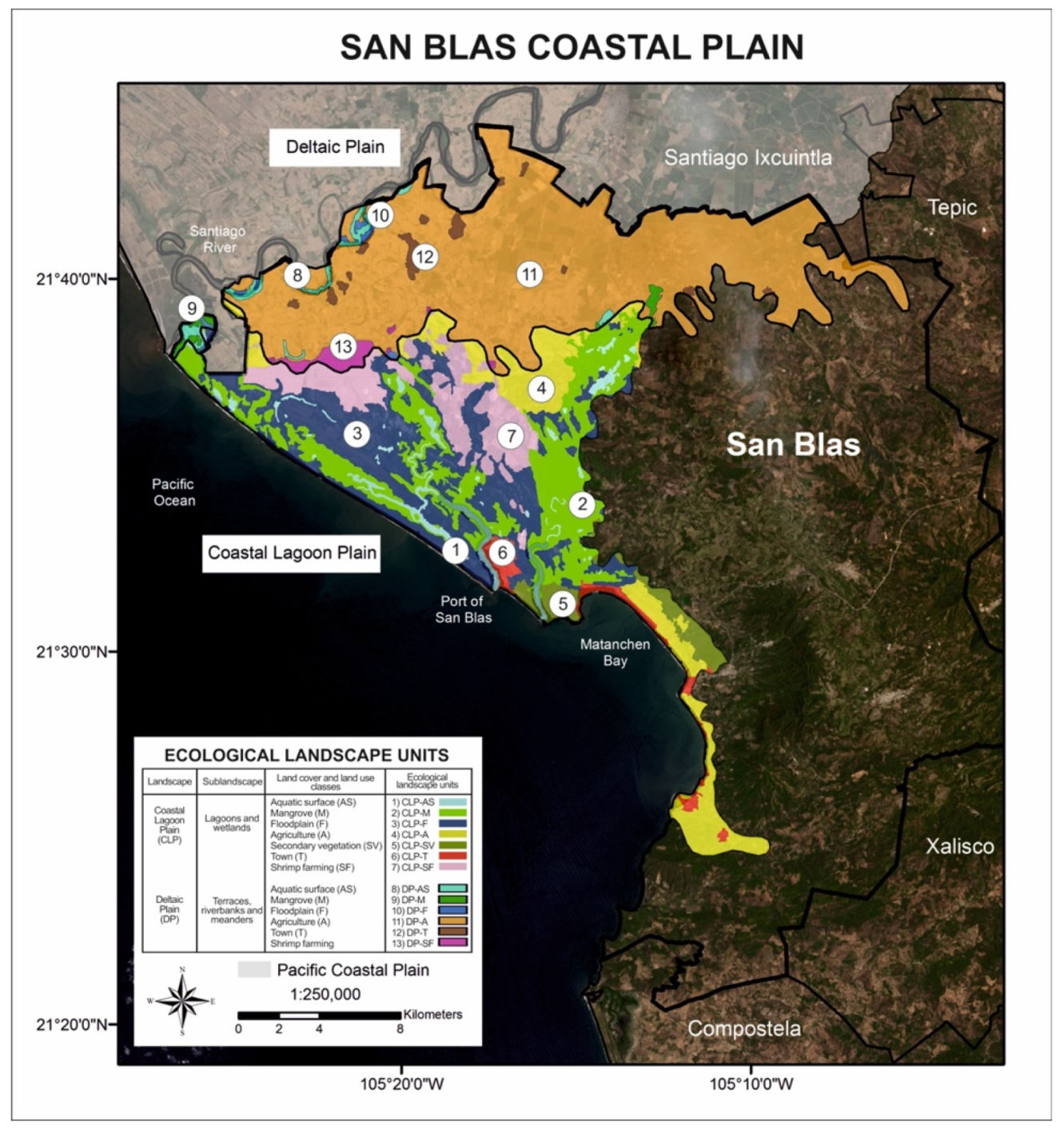
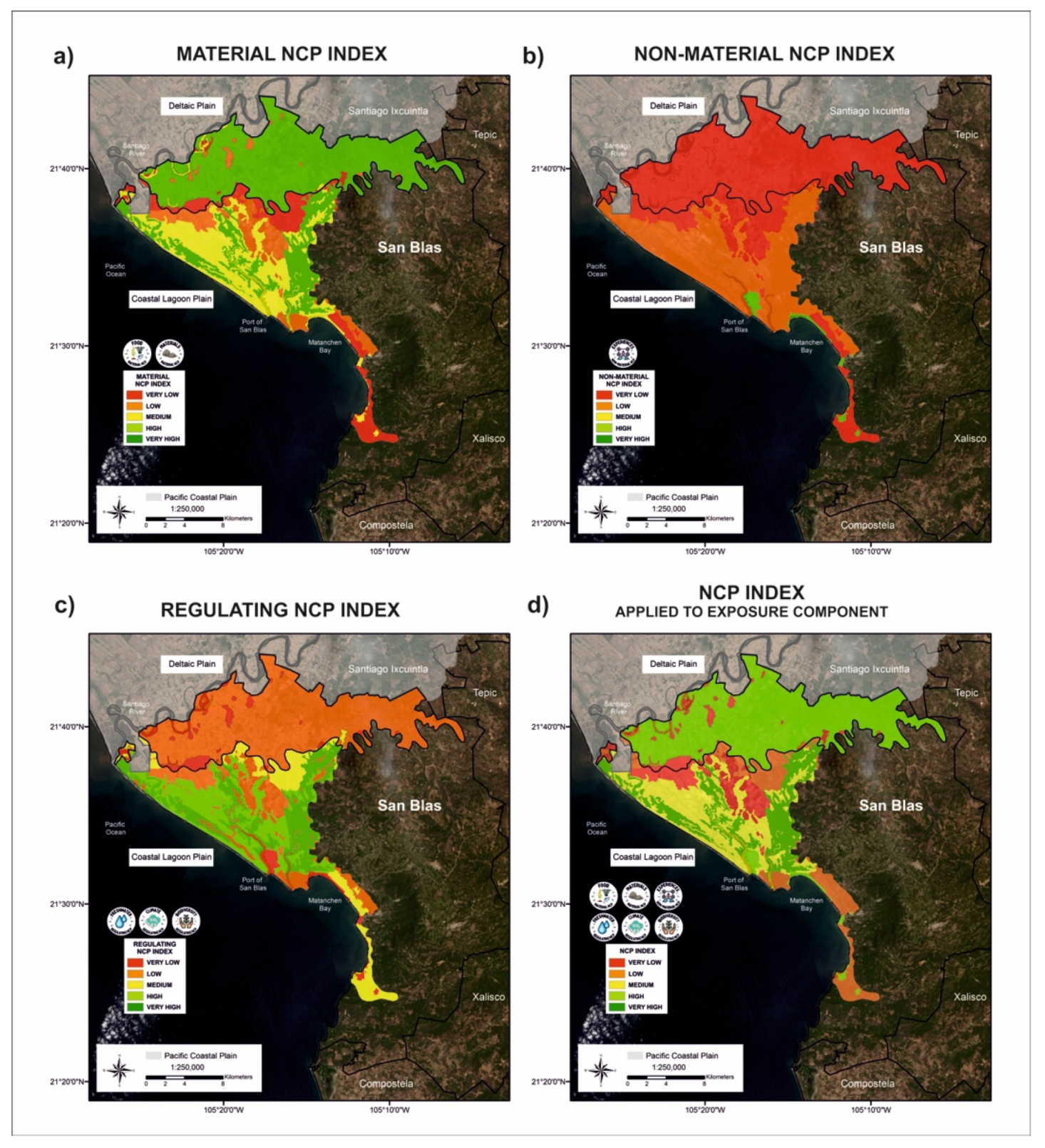
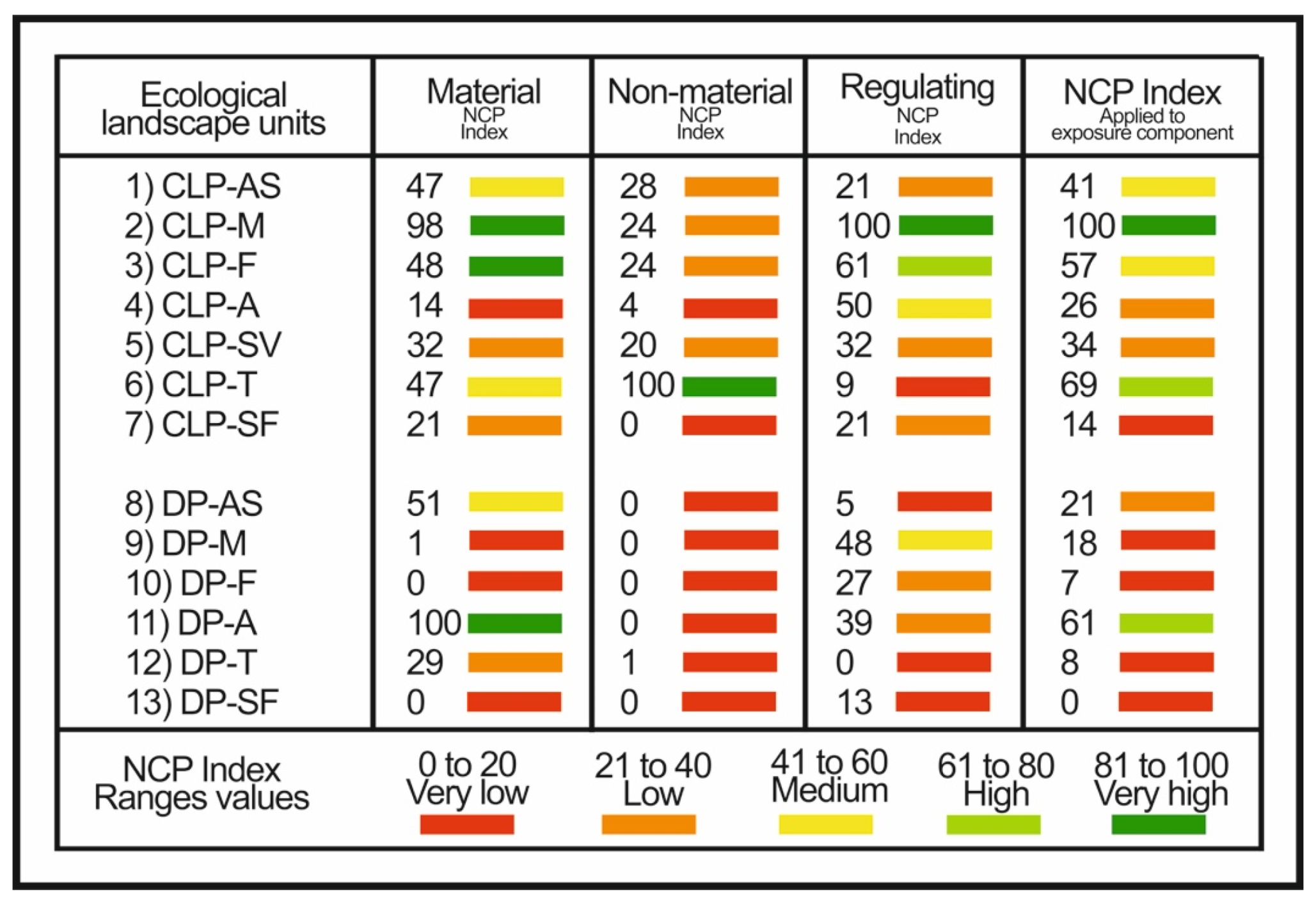
Publisher’s Note: MDPI stays neutral with regard to jurisdictional claims in published maps and institutional affiliations. |
© 2022 by the authors. Licensee MDPI, Basel, Switzerland. This article is an open access article distributed under the terms and conditions of the Creative Commons Attribution (CC BY) license (https://creativecommons.org/licenses/by/4.0/).
Share and Cite
Nájera González, A.; Carrillo González, F.M.; Nájera González, O.; Chávez-Dagostino, R.M.; Marceleño Flores, S.; Canales-Gómez, E.; Téllez López, J. Nature’s Contributions to People in Vulnerability Studies When Assessing the Impact of Climate Change on Coastal Landscapes. Sustainability 2022, 14, 4200. https://doi.org/10.3390/su14074200
Nájera González A, Carrillo González FM, Nájera González O, Chávez-Dagostino RM, Marceleño Flores S, Canales-Gómez E, Téllez López J. Nature’s Contributions to People in Vulnerability Studies When Assessing the Impact of Climate Change on Coastal Landscapes. Sustainability. 2022; 14(7):4200. https://doi.org/10.3390/su14074200
Chicago/Turabian StyleNájera González, Areli, Fátima Maciel Carrillo González, Oyolsi Nájera González, Rosa María Chávez-Dagostino, Susana Marceleño Flores, Eréndira Canales-Gómez, and Jorge Téllez López. 2022. "Nature’s Contributions to People in Vulnerability Studies When Assessing the Impact of Climate Change on Coastal Landscapes" Sustainability 14, no. 7: 4200. https://doi.org/10.3390/su14074200
APA StyleNájera González, A., Carrillo González, F. M., Nájera González, O., Chávez-Dagostino, R. M., Marceleño Flores, S., Canales-Gómez, E., & Téllez López, J. (2022). Nature’s Contributions to People in Vulnerability Studies When Assessing the Impact of Climate Change on Coastal Landscapes. Sustainability, 14(7), 4200. https://doi.org/10.3390/su14074200





